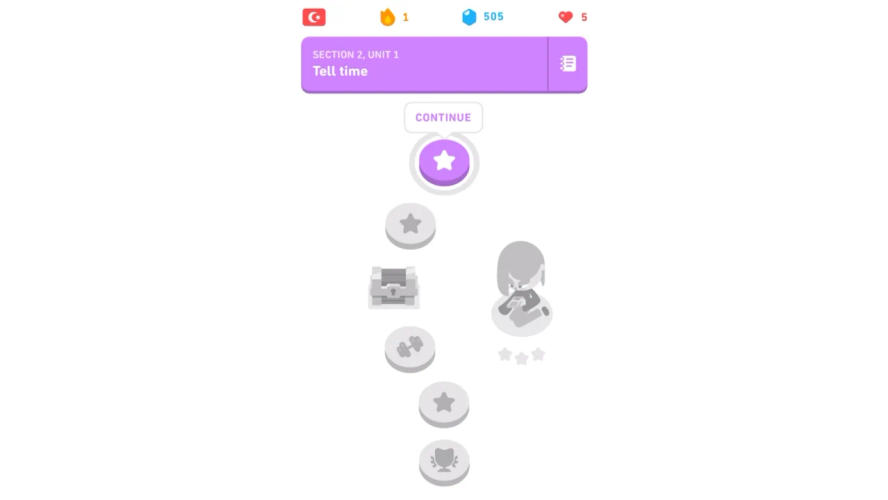When it comes to language learning, many people turn to Duolingo for its ease of use and gamified experience. While Duolingo is a popular choice, especially for beginners, it’s essential to ask whether or not Duolingo can actually guide you to fluency. In this post, I’ll give my Duolingo review, having explored their Turkish and Hindi courses, and share some thoughts on the app’s pros and cons for the language learner.
Why Turkish and Hindi?
Yes, I acknowledge that Turkish and Hindi are not Duolingo’s most popular (nor most developed) courses. However, I chose to test out Duolingo with these languages for a couple of reasons. One, my wife and I are planning a trip to Turkey this fall. I’ve already spent some time studying the language, so I have a decent foundation—probably somewhere between A2 and B1. On the other hand, Hindi is completely new to me. I want the insight of using Duolingo as a novice learner.
In short, I wanted to test out Duolingo as both a complete beginner as well as a learner with some prior knowledge in the target language.
Turkish on Duolingo: Revisiting What I Know
I spent about three months studying Turkish four years ago. While I’m not fluent, I know enough to revisit it on Duolingo without starting from scratch.
I started Duolingo’s Turkish course by taking a diagnostic test, introducing me to the lesson format and key features of the app. My initial thoughts on Duolingo’s Turkish lessons? They’re quite basic, which was both good and bad.
Simple exercises: I found myself doing lessons like translating basic sentences such as “The cat is sleeping.” While this is easy, it’s important to note that the difficulty is quite limited. This may be useful for practicing basic structures with lots of repetition, but the app does not seem apt to augmenting difficulty or complexity.
Identifying areas of improvement: I did find that, through Duolingo’s lessons, I had gotten rusty with Turkish verbs. Turkish verbs can be tricky, and I still found myself confusing first- and third-person conjugations. Duolingo was a helpful reminder of things I hadn’t fully mastered.
While the exercises reinforced my existing knowledge, I doubt that 15 minutes a day is enough for substantial progress. Duolingo promises fluency with consistent practice, but based on my experience, it’s more of a supplementary tool for consistent repetition and identifying areas (grammatical or lexical) that may need more prioritization in the future. The style of Duolingo’s lessons are not conducive to reaching conversational proficiency.
An Introduction to Hindi: A Whole New Script
Starting Hindi from scratch was a different experience altogether. The Devanagari script used in Hindi isn’t something you can pick up easily, and I wanted to see how Duolingo approaches this challenge.
Duolingo throws new letters at you quickly, often without context. This made it difficult to absorb everything, even with the format of bite-sized lessons. I’d sum up my experience learning Hindi on Duolingo with the following observations:
Guesswork: Early on, I found myself guessing at answers without a clear understanding of why something was right or wrong. For example, distinguishing between similar-sounding vowels was a struggle.
Script confusion: The introduction of the Hindi script was a challenge, and without a solid foundation or context to rely on, it was difficult to keep up with the exercises. I wasn’t actually being introduced to the language with these lessons. I was only able to interact with the script.
Too many mistakes: Given that I wasn’t grasping the writing system quickly enough, committing several errors, I ran out of “Hearts” in the middle of my Duolingo lesson. I had to either stop mid-lesson, pay to continue learning, or refer a friend for more “Hearts.” Under the impression that Duolingo was a completely free platform, I found this a bit odd.
The Good: Why Duolingo Works
- Fun and Easy to Use

Duolingo excels at making language learning fun. The app’s structure makes it satisfying to get things right, and you’re constantly encouraged to keep trying if you answer questions incorrectly.
- Maintaining Contact with the Language
For casual learners or those looking to maintain a light connection with a language, Duolingo is perfect. A few minutes here and there, especially on a daily basis, can help you stay connected with a language you’ve studied before.
- Great for Beginners
For someone just starting out with a language, Duolingo offers a no-pressure environment to test the waters. It gives learners a taste of the language without requiring them to dive deep into complicated grammar or syntax right away.
The Bad: Limitations of Duolingo
- Lack of Control Over What You Learn
One of my biggest frustrations with Duolingo is the lack of control. You can’t choose what to focus on—Duolingo decides what lessons to present. For someone like me, who wants to revisit certain aspects of Turkish grammar, this can be limiting. I want to be able to review specific lessons or words, but Duolingo doesn’t allow for that level of customization.

- Limited Depth
Duolingo’s lessons are too disjointed for more serious learners. You learn small, unrelated bits of the language, which doesn’t help much in building a thorough understanding of the language. For Turkish, for example, I’d prefer to spend more time on complex sentences or richer texts, which Duolingo doesn’t really offer.
- Not Enough for Fluency
Can you become fluent with Duolingo? Based on my own experience and conversations with others, the answer is no.
One of my acquaintances has been maintaining a 1,500-day streak in Spanish on Duolingo, but still faces challenges when it comes to speaking the language fluently. While the app offers bite-sized practice sessions, it may not be sufficient as the sole resource to achieve fluency.
In conclusion, Duolingo is a user-friendly tool for language learning, but it does have its limitations. It can be a valuable asset for beginners or casual learners looking to engage with a language on a daily basis. However, if your ultimate goal is fluency or a deeper understanding of a language, it is advisable to supplement Duolingo with other resources.
I view Duolingo not as a rival to other language learning platforms, but rather as a complementary tool. For those serious about mastering a language, I suggest combining Duolingo with books, apps like LingQ, and real-world practice.
Have you utilized Duolingo for language learning? What has been your experience with it? Feel free to share your thoughts in the comments section below!
Source link





